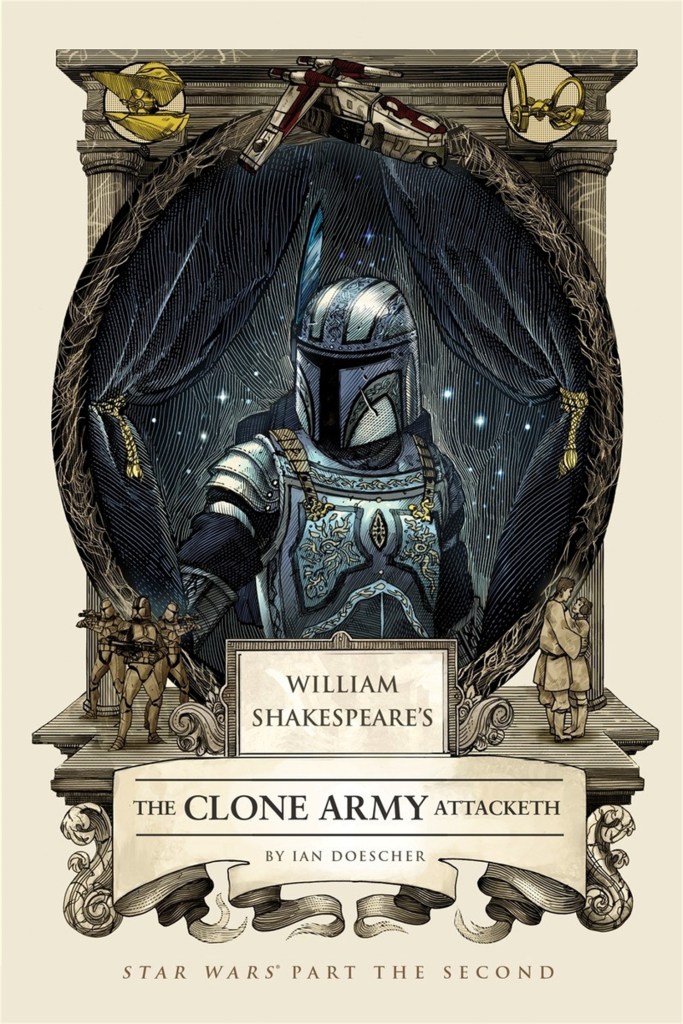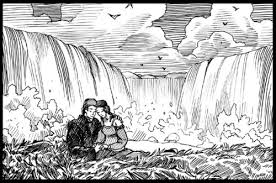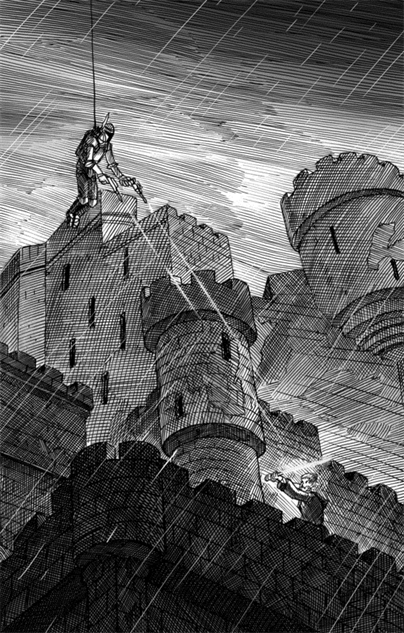
On July 7, 2015, Philadelphia-based Quirk Books published Ian Doescher’s William Shakespeare’s The Clone Army Attacketh: Star Wars Part the Second, the fifth book in a series of nine in which the author reimagines the Skywalker Saga as plays written by the greatest dramatist in English literature – William Shakespeare.
Doescher, who was born in 1977 – 45 days after the premiere of writer-director George Lucas’s original Star Wars movie – and became enthralled with the works of the Bard of Avon in eighth grade, reworks Lucas’s 2002 Prequel film Star Wars Episode II: Attack of the Clones as a drama for an Elizabethan-era theater, with the stylistic conventions of Shakespeare’s time: a five-act structure, dialogue written mostly in iambic pentameter, minimal stage directions, asides, soliloquies, and even rhyming couplets at the end of scenes.
In William Shakespeare’s The Clone Army Attacketh, the mythical galaxy far, far away is in turmoil as the Sith – an evil offshoot of the Jedi Order that uses the Dark Side of the Force to achieve its goals of galactic domination and the destruction of the Jedi – manipulate events to weaken the once-great Galactic Republic and accelerate Darth Sidious’ execution of a plan set in motion a thousand years earlier:
Prologue.
Outer space.
CHORUS: All hurly-burly goes the galaxy –
The Senate sees a time of harsh unrest.
For many thousand systems do decree
Intent to leave th’ Republic’s troubled nest.
This movement of the sep’ratists is led
By one Count Dooku, garb’d in mystery.
The Jedi Knights are press’d and thinly spread:
The peace they keep grows weaker by degree.
A vital vote the Senate doth pursue:
Shall they an army for th’ Republic make?
Strong senator – Am’dala of Naboo –
To Coruscant makes way, this plan to break.
In time so long ago begins our play,
In clash-strewn galaxy far, far away.
[Exit.

Between the Covers
Taking his cues from the screenplay by George Lucas and Jonathan Hales, Doescher, writing in the style of Shakespeare, picks up the story a decade after the events of Star Wars Episode I: The Phantom Menace. Amidst a backdrop of impending civil war as the Confederacy of Independent Systems threatens to sway even more star systems away from the Republic, 19-year-old Anakin Skywalker and his Jedi teacher, Obi-Wan Kenobi, are tossed into a maelstrom of sinister plots and intrigue after an assassination attempt against Senator Padmé Amidala.
The former Queen of Naboo is opposed to the Military Creation Act; she fears that if the Senate, led by Supreme Chancellor Palpatine, raises a standing army for the Galactic Republic, the Separatists will see it as an escalation in the dispute over secession and be prompted to take up arms against the central government. In this matter, Padmé has many opponents, including Senators and close advisers to Palpatine, who support a tougher stance against Count Dooku’s Separatist movement.
With many enemies within and without the halls of power in Coruscant, it isn’t too long before Padmé is targeted for death. So when a mysterious assassin destroys Padmé’s Royal Naboo Cruiser on a Senate landing pad, Palpatine, her former Ambassador and now-Supreme Chancellor of the Republic, asks the Jedi Council to protect the idealistic Senator:
PALPATINE: Brave Master Jedi, humbly I suggest
The senator be safeguarded by you.
BAIL: Is ’t wise to play our hand in such a way,
Since this grave moment bringeth such distress?
PADMÉ: Sir Chancellor, if you would hear me speak:
‘Tis not my wish, nor is it my belief –
PALPATINE: ‘Tis not your belief, young senator,
Our situation hath become so dire?
It may not be, and yet I disagree:
The tide of these affairs hath turn’d most rough,
And threatens now to overturn the ship
Of our Republic. ‘Tis most serious.
Whilst I do grasp that this additional
Security may be most noisome, it
Is also vital you protected are.
Mayhap if ‘twere a Jedi you know well –
A friend of times gone by, I have the man:
E’en Master Obi-Wan Kenobi. Yes?
MACE: ‘Tis possible. He hath return’d e’en now:
A border quarrel nearby Ansion –
With each combatant raging like a moose –
He hath of late o’erseen, and presently
He hath made his return to Coruscant.
PALPATINE: If not for your fond people of Naboo,
If not for the Republic that you serve,
If not for this grim danger you are in,
Do it, if not for these, then for my sake.
When my mind ponders thought of losing you,
‘Tis more, my lady, than my soul can bear.
MACE: Brave Obi-Wan shall make report to you
Immediately, lady. And fear not:
He shall be most discreet, and out of sight,
E’en though he ever guards you steadily.
PADMÉ: Kind Master Windu, take mine utmost thanks.
[Exeunt Palpatine, Padmé, Typho, Yoda, Mace Windu, Ki-Adi Mundi, and Jedi Council members.
Palpatine’s suggestion – both in the Lucas-Hale screenplay and Doescher’s pastiche – seems to be born from genuine concern, at least on the surface. But most Jedi on field assignments work in pairs – a Master and an apprentice – and Palpatine chooses Kenobi not just because he is available, but because Kenobi’s Padawan just happens to be Anakin Skywalker, a talented but tempestuous boy on the cusp of manhood.
Anakin – who started his Jedi training at the advanced age of nine – is strong in the Force and an adept pilot, mechanic, and cunning warrior. But because he started his training much later than Jedi tradition demanded and is scarred by the separation from his mother Shmi, Anakin is vulnerable to temptations that a properly-trained and indoctrinated Padawan usually resists.
One of those temptations is the beautiful former Queen of Naboo, Senator Padmé Amidala. Anakin first met her ten years earlier on Tatooine during the Naboo Crisis, when she, along with Jedi Master Qui-Gon Jinn and the Gungan radical known as Jar Jar Binks, entered the shop owned by Anakin’s former slave master Watto the Toydarian in search of spare parts to repair their damaged starship. Despite the fact that Padmé is five years older than Anakin, the young boy was smitten by her; 10 years of training and living as a Jedi have not diminished Anakin’s feelings of attachment to the outspoken and attractive Senator.

To make matters worse, Anakin has been counseled – with the tacit approval of the Jedi Council – by Supreme Chancellor Palpatine. After all, the former Senator from Naboo is an unassuming, honest, and well-respected politician who has avoided scandal and any taint of corruption or too much ambition. Elected to lead the Republic just as the Battle of Naboo reached its climax, Palpatine has served his constitutionally-mandated two terms; the Senate, we’re told, asked him to remain in office as a result of the Separatist crisis.
That’s what the Jedi know, at any rate. So they apparently did not object to Palpatine’s actions – off-stage, of course – of keeping an eye on young Skywalker’s career and becoming a sort of extracurricular consiglieri to the boy.
But as Yoda admits early in Act One:
The dark side rises –
Cloudeth ev’rything it doth.
Thus, the future hides.
Not only do the Jedi not see the future; they also do not suspect that Palpatine is leading a double life. To them, the Senate, and the Republic’s vast number of citizens, he is the beloved and incorruptible defender of democracy and peace. But beneath his smiling, unctuous façade, Sheev Palpatine is the scheming and evil Darth Sidious.
So if Palpatine wants Obi-Wan Kenobi, the poster boy for what every good Jedi should be, to protect Padmé from danger, it’s with ulterior motives in mind.
William Shakespeare’s The Clone Army Attacketh follows our cast of heroes, villains, and droids in a series of adventures that will take them from the crowded city-planet Coruscant to various worlds familiar to viewers of the Skywalker Saga: the desert planet of Tatooine, the storm-tossed sea world of Kamino, Padmé’s idyllic home world of Naboo, and the dangerous arid planet Geonosis, home to the Separatists’ bustling war manufacturing machine – and birthplace of the first dreaded Death Star!
Up Front: The Cover

Once again, illustrator Nicolas Delort returns to give bounty hunter Jango Fett (father of Boba) a a decidedly villainous yet charmingly retro look. Because Delort matches the styles worn by European warrior in Shakespeare’s time and Trisha Beggar’s designs for Jango Fett in Attack of the Clones, the central figure on the book cover is an interesting synergy between the “look” of the late 1500s and the late 1990s.
The central illustration of Fett is flanked by smaller depictions of (clockwise from left top) Count Dooku’s solar sailer, a Republic gunship, a Hellfire mobile missile platform, clone troopers, and the starcross’d lovers, Anakin and Padmé. Like all of the characters in this series, the clone troopers, Anakin, and Padmé wear Elizabethan-era variants of their outfits from Attack of the Clones, looking more like personages from the late 1500s rather than 2002-era space fantasy movie characters.
The Book

To Shmi, or not to Shmi?
The curtain rises on yeoman Jedi Anakin Skywalker, a man torn between duty to his Masters, attraction to Padmé, and concern for his beloved mother, Shmi. His choices will determine not just his own destiny, but that of the entire Republic. And thereby hangs a tale.
Out, damned Fett!
A noble lady in danger. A knight and squire in battle. And a forbidden love written in the stars. The quill of William Shakespeare meets the galaxy of George Lucas…complete with period illustrations, insightful soliloquies, and masterful meter that will convince you the Bard himself penned this epic adventure. – Publisher’s dustjacket blurb, William Shakespeare’s The Clone Army Attacketh
The hardcover edition of William Shakespeare’s The Clone Army Attacketh is not a huge, bulky volume; the book is only 176 pages long, including the Dramatis Personae page, the Afterword (in which Doescher discusses how he made Jango Fett talk in prose, why various creatures sing or spout asides, why Mace often refers to Samuel L. Jackson movies in his lines, explains some of the techniques used to mix Attack of the Clones with the plays of William Shakespeare, and reminds readers what iambic pentameter is), and the Acknowledgments page. It measures 5.2 x 0.8 x 8 inches and weighs less than 1 lb.
My Take
PADME:
Nay, thou shalt listen, my soul warranteth:
The tempter or the tempted, who sins most?
The vision thou dost proffer suits us not,
Thine honor nor my station, neither one.
Reality it seems thou hast forgot,
For us to love would mean us both undone.
Thou art a Jedi, I a Senator,
If thou wouldst follow thy thoughts to their end
Then wouldst thou with my judgement straight concur:
I am not made for lover, but for friend.
This must be so, regardless how we feel,
And how our passions move toward each other. — William Shakespeare’s The Clone Army Attacketh (III.i.140-151),

I started reading William Shakespeare’s The Clone Army Attacketh: Star Wars Part the Second at a difficult time in my life. I pre-ordered it on Amazon in early April 2015, but it wasn’t published until July 7 of that year. The book arrived at the Miami townhouse that I shared with my elderly mother around the same time that she was taken twice within a two-week timespan to Kendall Regional Hospital due to respiratory distress and a failing heart. The Clone Army Attacketh was one of the many books I was listlessly leafing through while I waited for word on my mother’s condition; I was probably trying, without much success, to give my stress-filled mind a break from the stark reality that my mother would not live much longer.
My mom was placed under hospice care at home – she had always said she did not want to die in a hospital – and she died there on July 19, 2015, less than a week after her release from the hospital. And in the weeks and months that followed – marked by dealing with insurance companies, settling my mother’s last financial obligations, closing her credit card accounts, and coping with a host of other challenges, I didn’t have the time to delve deeply into the pages of William Shakespeare’s The Clone Army Attacketh.
Now, of course, with the changes to my work schedule made necessary by the stay-at-home rules that we live under in the times of COVID-19, I have had more reading time than usual. So I have been reading quite a few books over the past eight weeks, including several Star Wars tie-in books.
As I have stated in my previous reviews of the William Shakespeare’s Star Wars series – I have all eight of the published ones, and I preordered William Shakespeare’s The Merry Rise of Skywalker, which is due out in July – I am not more than a casual Shakespeare reader. In my library I have the paperback editions of Macbeth and The Taming of the Shrew that my 12th grade English class studied as part of the Shakespeare unit in the 1982-83 school year. I also have a battered paperback of Romeo and Juliet/West Side Story, plus Blu-rays of Branagh’s Henry V and John Madden’s Shakespeare in Love.
(I also saw a performance of Othello at the Miami Beach Theater of the Performing Arts in Miami back in 1981; I remember it vividly because James Earl Jones played the title role, and Christopher Plummer played Iago.)
I am, however, a Star Wars fan and a writer, and the notion of seeing my favorite movie series (now, a multimedia franchise) reimagined as a series of plays written in the style of Shakespeare struck me as interesting. I was curious to see how Doescher did it, so starting in 2014 I began my exploration of this best-selling pastiche by buying William Shakespeare’s Star Wars Trilogy.
As a lover of the English language, a writer, and voracious reader, I have learned that Shakespeare was a genius on many levels, and that his gifts as a writer, dramatist, and poet were many. He wasn’t just a writer and poet with a keen eye for language and dramatic situations, but as an accomplished and observant actor himself, Shakespeare understood the human condition. So many of his phrases (“the milk of human kindness,” “elbow room,” “faint-hearted,” and “star-crossed”) are part of the modern English language and vocabulary. Furthermore, many of the themes he explored in his histories, comedies, and tragedies have been used time again by many storytellers, including, of course, George Lucas and his heirs in the Lucasfilm Story Group. That’s why his 37 or so plays still stand the test of time, and that’s why The Clone Army Attacketh is so much more than a fun-but-smart parody of a space-fantasy film.

In many ways, William Shakespeare’s The Clone Army Attacketh is a great way to introduce Shakespeare to casual readers or folks that only read a few of his plays in high school English classes. Ian Doescher is both a Bard “geek” and a Star Wars fan, so he can draw upon the works of a man who died in 1616 and skillfully combine famous lines from various plays with the 20th and 21st Century works of George Lucas, Lawrence Kasdan, Jonathan Hales, and, later, J.J. Abrams, Chris Terrio, and Rian Johnson. The resulting alchemy: a series of plays that pulls off the illusion that indeed, William Shakespeare wrote the Skywalker Saga!
As Boing Boing’s book critic wrote in 2014 about the original William Shakespeare’s Star Wars Trilogy:
“Not a campy or goofy parody, but a surprisingly well-done tribute, this is a special treat. The artwork is also fantastic.” – Back cover blurb, William Shakespeare’s The Clone Army Attacketh
This is a fun-to-read, laugh-out-loud, and extremely well-written work. It is full of drama, comedy, action, and – if you are new to the Star Wars saga – even some suspense. Moreover, since it is a pastiche, it is a good way to introduce younger readers – say, of high school age – to the style of William Shakespeare before tackling a play like Hamlet or Julius Caesar. And most of all, Doescher adds lots of puns, clever wordplay – Shakespeare loved playing with the English language and added much needed humor in his works – and pop culture references (Easter eggs), some of which are not remotely related to either Shakespeare or Star Wars.
As someone who loves good writing and the Skywalker Saga, I heartily recommend William Shakespeare’s The Clone Army Attacketh. It is the book you’re looking for.

Comments
One response to “Book Review: ‘William Shakespeare’s The Clone Army Attacketh: Star Wars Part the Second’”
Interesting review/preview, Alex. Enjoyed it.
LikeLiked by 1 person